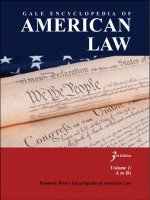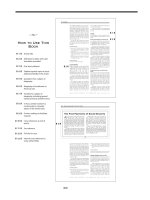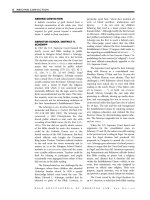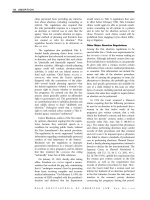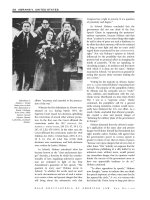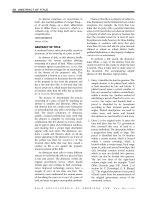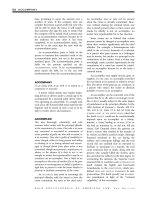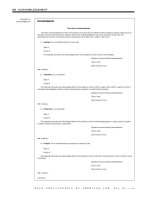Gale Encyclopedia Of American Law 3Rd Edition Volume 1 P16 docx
Bạn đang xem bản rút gọn của tài liệu. Xem và tải ngay bản đầy đủ của tài liệu tại đây (153.91 KB, 10 trang )
A majority of the state statutes provide for the
release of identifying information when the
birth parents have consented to such release.
One method that states use to organize such
consents is a mutual consent registry, which is a
system whereby individuals involved in the
adoptions can indicate whether they will allow
for their identifying information to be disclosed.
Approximately 29 states have devised some type
of registry. Other states have in place a type of
search-and-consent system, which allows for the
adoption agency to assist a party in locating birth
family members if the birth family members
consent to the release of the information.
Most state statutes deny adoptees access to
records that disclose identifying information
about the natural parents in situations where
the consent of the birth parents is not on record.
The natural parents often make their consent to
the adoption contingent upon the condition that
no information about them ever be revealed. Yet,
many states now have instituted procedures for
which a party to an adoption may obtain non-
identifying information. Non-identifying infor-
mation may include, but is not limited to, the
following: the date and place of the adopted
person’s birth and the birth parents’ age, physical
description, race, ethnicity, religion, and medical
history. Some states are more restrictive than
others regarding the release of information from
the adoption records. For example, New York,
Oklahoma, and Rhode Island require that any
person seeking non-identifying information
must first register with the state adoption registry
prior to receiving such information.
Because of a growing
PUBLIC INTEREST in
tracing ethnic and family backgrounds, many
adoptees, as adults, have been calling for the
right to obtain access to sealed adoption
records, which includes identifying informa-
tion. The adult adoptees recognize that a
disclosure of this kind of information could be
traumatic to minor adoptees, but they contend
that lack of access could cause serious psycho-
logical trauma to them as adults. In addition,
they cite medical problems or misdiagnoses that
could be caused by absence of genetic history, as
well as fear of unwitting
INCEST.
Adult adoptees contend that most adoption
statutes do not draw a distinction between
adoptees as minors and later as adults, which
causes the adults to be deprived of the right to
trace their background. In addition, the adults
allege that they have been denied
EQUAL PROTEC-
TION
of law because their status precludes them
from receiving medical information readily
available to non-adoptees.
Various approaches are being used to resolve
this problem. One approach involves the enact-
ment of a legislative requirement that public and
private adoption agencies be required to open
their records, upon request, to adults who were
adopted as children, with certain limitations. For
example, if the child had been placed by the
natural parents prior to the effective date of
the legislation, the natural parents could prevent
the adoptee from seeing the records.
The issue of right to access to adoption
records by adoptees when they reach adulthood
also encompasses the legal consideration of the
natural parents’ right to privacy, which could be
violated if free access to sealed court records
were given to adult adoptees. The adult
adoptees’ right to know must be balanced
against their natural parents’ right to privacy.
The way to achieve such a balance, however, has
never been clearly determined.
In September 1999 Tennessee’s Supreme
Court overturned the Tennessee Court of
Appeals ruling in Doe v. Sundquist, 2 S.W.3d
919 (Tenn., Sep 27, 1999) (NO. 01-S-01-9901-
CV00006), which challenged a law passed in
1995 that unsealed both adoption records and
original birth certificates to adult adoptees.
Earlier, the U.S. Court of Appeals for the 6th
CIRCUIT COURT had ruled in favor of the state and
opined, much to the dismay of sealed records
advocates: “A birth is simultaneously an inti-
mate occasion and a public event—the govern-
ment has long kept records of when, where, and
by whom babies are born. Such records have
myriad purposes, such as further ing the interest
of children in knowing the circumstances of
their birth,” Doe v. Sundquist, 106 F.3d 702, 65
USLW 2527, 1997 Fed.App. 0051P (6th Cir.
(Tenn.) Feb 11, 1997) (NO. 96-6197). The U.S .
Supreme Court, however, elected not to hear
the Tennessee case.
FURTHER READINGS
“Access to Adoption Records, State Statutes Series.”
Available online at />wide/laws_policies/statutes/infoaccessap.cfm; website
home page: (accessed June
11, 2009).
Carp, E. Wayne, ed. 2002. Adoption in America: Historical
Perspectives. Ann Arbor: University of Michigan Press.
GALE ENCYCLOPEDIA OF AMERICAN LAW, 3RD E DITION
138 ADOPTION
DuPrau, Jeanne. 1990. Adoption. Englewood Cliffs, N.J.:
Messner.
Embry v. Ryan Florida App. No. 2D08-1323 (May 13, 2009).
Marshner, Connaught, ed. 1999. Adoption Factbook III.
Washington, D.C.: National Council for Adoption.
Manian, Maya. 2009. “The Irrational Woman: Informed
Consent and Abortion Decision-Making”. Duke Journal
of Gender Law and Policy. August.
Melosh, Barbara. 2002. Strangers and Kin: The American
Way of Adoption. Cambridge, Mass.: Harvard Univer-
sity Press.
Rundberg, Gayle D. 1988. How to Get Babies through Private
Adoption. Bend, Ore.: Maverick.
Sloan, Irving J. 1988. The Law of Adoption and Surrogate
Parenting. London: Oceana.
“Total Adoptions to the United States.” Available online at
website
home page: (accessed June 11,
2009).
Van Alstyne, William. 2009. “The Unbearable Lightness of
Marriage in the Abortion Decisions of the Supreme
Court: Altered States in Constitutional Law.” William
and Mary Bill of Rights Journal. October.
CROSS REFERENCES
Child Custody; Child Support; Children’s Rights; Family
Law; Illegitimacy; Infants; Parent and Child; Surrogate
Motherhood.
ADULT
A person who by virtue of attaining a certain age,
generally eighteen, is regarded in the eyes of the
law as being able to manage his or her own affairs.
The age specified by law, called the legal
AGE
OF MAJORITY
, indicates that a person acquires full
legal capacity to be bound by various docu-
ments, such as contracts and deeds, that he or
she makes with others and to commit other
legal acts such as voting in elections and
entering
MARRIAGE. The age at which a person
becomes an adult varies from state to state and
often varies within a state, depending upon the
nature of the action taken by the person. Thus,
a person wishing to obtain a license to operate a
motor vehicle may be considered an adult at
age sixteen, but may not reach adulthood until
age eighteen for purposes of marriage, or age
twenty-one for purposes of purchasing intoxi-
cating liquors.
Anyone who has not reached the age of
adulthood is legally considered an infant.
ADULTERATION
Mixing something impure with something genu-
ine, or an inferior article with a superior one of
the same kind.
Adulteration usually refers to mixing other
matter of an inferior and sometimes harmful
quality with food or drink intended to be
sold. As a result of adulteration, food or drink
becomes impure and unfit for human consump-
tion. The federal
FOOD AND DRUG ADMINISTRATION
prohibits transportation of adulterated foods,
drugs, and cosmetics in interstate commerce, as
provided under the Food, Drug and Cosmetic
Act (21 U.S.C.A. § 301 et seq. [1938]). State and
local agencies, acting under the authority of local
laws, do the same to ban the use of such impure
goods within their borders.
ADULTERY
Voluntary sexual relations between an individual
who is married and someone who is not the
individual’s spouse.
Adultery is viewed by the law in many
jurisdictions as an offense injurious to public
morals and a mistreatment of the
MARRIAGE
relationship.
Statutes attempt to discourage adultery by
making such behavior punishable as a crime
and by allowing a blameless party to obtain a
DIVORCE against an adulterous spouse.
Although adultery has been historically
regarded as a legal wrong, it has not always
been considered a crime. In Europe during the
fifteenth and sixteenth centuries, adultery was
punishable solely in courts created by the
church to impose good morals. In the
ECCLESIAS-
TICAL COURTS
, adultery was any act of sexual
intercourse by a married person with someone
not his or her spouse. The act was considered
wrongful regardless of whether the other person
was married. At
COMMON LAW, adultery was
wrongful intercourse between a married woman
and any man other than her husband.
Criminal Laws
Several state legislatures statutorily prohibit
adultery as a crime. Under some statutes, both
parties to an adulterous relationship are guilty
of a crime if either of them is married to
someone else. Other statutes provide that the
act is criminal only if the woman is married.
Under the law of many states, a single act of
adultery constitutes a crime, whereas in others,
there must be an ongoing and notorious
relationship. The punishment set by statute
may be greater for an individual who engages in
GALE ENCYCLOPEDIA OF AMERICAN LAW, 3RD E DITION
ADULTERY 139
repeated acts of adultery than for one who
commits an isolated act.
Defenses An individual who has been charged
with committing adultery may have a valid legal
defense, such as the failure or physical incapac-
ity to consummate the sex act.
Awomanisnotguiltyofadulteryifthesexact
resulted from
RAPE. Some states recognize igno-
rance of the accused regarding the marital status
of his or her sexual partner as a defense. In a few
jurisdictions only the married party can be
prosecuted for adultery. If the other party to
the relationship is not married, he or she may be
prosecuted for fornication instead of adultery.
Initiation of Criminal Proceedings Under
some statutes, a prosecution for adultery can be
brought only by the spouse of the accused person
although technically the action is initiated in the
name of the state. Other states provide that a
husband or wife is precluded from commencing
prosecution for adultery since those states have
laws that prohibit a husband or wife from
testifying against his or her spouse. In such states,
a complaint can be filed by a husband or wife
against the adulterous spouse’slover.
Evidence Customary rules prescribe the types of
evidence that can be offered to prove guilt or
innocence. There must be a showing by the
PROSECUTOR that the accused party and another
named party had sexual relations. Depending on
state statutes, the prosecutor must show that
either one or both parties to the adultery were wed
to someone else at the time of their relationship.
Evidence that the
DEFENDANT had the chance
to have sexual relations coupled with a desire, or
opportunity and inclination, might be sufficient
to prove guilt. Photographs or
TESTIMONY of a
witness who observed the couple having sexual
intercourse is not necessary. The fact that a
married woman accused of adultery became
pregnant during a time when her husband was
absent might be admissible to demonstrate that
someone other than her spouse had the
opportunity of engaging in illicit sex with her.
Letters in which the accused parties have
written about their amorous feelings or clan-
destine encounters may be introduced in court
to support the assertion that the parties had
the inclination to engage in sexual relations.
CHARACTER EVIDENCE indicating the good or bad
reputation of each party may be brought
before the jury. Evidence of a woman’s sexual
relationships with men other than the party to
the adultery generally cannot be used; how-
ever, if her reputation as a prostitute can be
demonstrated, it may be offered as evidence.
Suspicious activities and incriminating cir-
cumstances may be offered as
CIRCUMSTANTIAL
EVIDENCE
.
Enforcement of Statutes
Although the District of Columbia and approx-
imately half of the states continue to have laws
on the books criminalizing adultery, these laws
are rarely invoked. Traditionally, states ad-
vanced three goals in support of their adultery
laws: (1) the prevention of disease and illegiti-
mate children; (2) the preservation of the
institution of marriage; and (3) the safeguarding
of general community morals.
Courts in the jurisdictions still prohibiting
adultery have openly questioned whether adul-
tery laws in fact serve these goals. The Florid a
Supreme Court, for example, found that
adultery statutes bear no rational, much less
compelling relationship to disease prevention.
The court said that the risk of contracting
disease is already a greater deterrent to extra-
marital sex than criminal punishment. The
court also noted that the fear of prosecution
prevents infected people from voluntarily seek-
ing treatment (Purvis v. State, 377 So. 2d 674,
677 [Fla.1979]).
At the same time, many prosecutors began
to realize that on ce the act of adultery is
committed, the harm to the marriage is for
the most part complete, especially if the
infidelity is disclosed or discovered. In other
words, after a spouse has been unfaithful, there
is little the judicial system can offer to undo the
act and reverse the damage. Thus, prosecutors
have increasingly questioned whether prosecut-
ing the adulterer will do much if anything to
preserve the marriage.
Finally, judges, prosecutors, and other state
officials have increasingly realized that prosecu-
tions for adultery have had little practical effect
in “safeguarding the community morals.”
Opinion polls consiste ntly show that significant
numbers of spouses admit to cheating on their
partners during marriage. In light of the
growing evidence that adultery laws no longer
serve their three underlying purposes, most state
prosecutors have made a conscious decision
GALE ENCYCLOPEDIA OF AMERICAN LAW, 3RD E DITION
140 ADULTERY
against wasting their scarce resources on pro-
secuting alleged adulterers.
In states that still have adultery laws on the
books, but have failed to
PROSECUTE anyone
under them recently, courts have ruled that the
mere lack of prosecution under the adultery
statute does not result in that statute becoming
invalid or judicially unenforceable. Courts have
also rejected the argument that prosecutions for
adultery are inconsistent with the right to
privacy guaranteed by state and federal con-
stitutions (Commonwealth v. Stowell, 389 Mass
171, 449 NE2d 357 [Mass 1983]).
As a Defense
Occasionally, adultery has been successfully
asserted as a defense to the crime of
MURDER
by an individual charged with killing his or her
spouse’s lover. Courts are loath, however, to
excuse the heinous crime of murder on the
ground that the accused party was agitated
about a spouse’s adu lterous activities. However,
individuals who kill their spouse after catching
him or her committing adultery may be able to
rely on a
HEAT OF PASSION defense, and thereby
face prosecution or conviction for
MANSLAUGHTER,
rather than first degree murder.
Divorce
Based on the state ’s interest in the marital status
of its residents, all legislatures had traditionally
assigned statutes enumerating the grounds on
which a divorce would be granted. These
grounds, listed separately in the laws of each
jurisdiction, generally includ ed
DESERTION, NON-
SUPPORT
, and adultery.
The basis of adultery as a ground for divorce
has been discussed in various cases. There is an
overriding
PUBLIC POLICY in favor of preserving
the sanctity of marital relationships and family
unity and a fear that adultery will serve to
undermine these societal objectives.
Late twentieth-century changes in divorce
laws, primarily the enactment of no-fault
divorce statutes in many states, have made it
easier for couples seeking divorce to end their
marriages without having to prove adultery or
any other ground. In the past many unhappy
couples resorted to trickery to attempt to obtain
a divorce through staging the discovery of
allegedly adulterous conduct.
Nonetheless, adultery still may be relevant
to divorce proceedings in which
ALIMONY is an
issue. In twenty-seven states plus Puerto Rico
and the District of Columbia, fault is one factor
which courts will consider in deciding whether
to
AWARD alimony. If the spouse seeking an
alimony award committed adultery, he or she
will have a more difficult time convincing the
court that he or she is entitled to alimony than
if he or she had not been unfaithful.
FURTHER READINGS
Duhaime, Lloyd. “Adultery.” Duhaime.org Web site.
Available online at />Dictionary/A/Adultery.aspx; website home page:
(accessed August 28, 2009).
Friedman, Lawrence M. 2000. “A Dead Language: Divorce
Law and Practice before No-fault.” Virginia Law Review
86 (October).
Haggard, Melissa Ash. 1999. “Adultery: A Comparison of
Military Law and State Law and the Controversy This
Causes under Our Constitution and Criminal Justice
System.” Brandeis Law Journal 37 (spring).
CROSS REFERENCES
Circumstantial Evidence; Common Law; Divorce; Ecclesi-
astical Courts; Family Law; Fornication; Husband and Wife;
Marriage; Privacy; Rape.
ADVANCE
To pay money or give something of value before
the date designated to do so; to provide capital to
help a planned enterprise, expecting a return from
it; to give someone an item before payment has
been made for it.
ADVANCE SHEETS
Pamphlets containing recently decided opinions of
federal courts or state courts of a particular region.
Cases appearing in advance sheets are subse-
quently published in bound volumes containing
several past pamphlets, usually with the same
volume and page numbers as appeared in the
advance sheets. Sometimes a court will publish an
individual opinion soon after it has been rendered
by the court. This is called a slip opinion, which
later may appear in an advance sheet.
Advance Sheets in the National
Reporter System
The National Reporter System, published by the
West Group, St. Paul, Minnesota, is the most
comprehensive collection of the decisions of the
appellate courts of the states and each of the
courts of the United States. Eighteen reporters
comprise the National Reporter System. Eight
units cover federal courts, including the
GALE ENCYCLOPEDIA OF AMERICAN LAW, 3RD E DITION
ADVANCE SHEETS 141
Supreme Court Reporter (cited as S. Ct.); the
Federal Reporter, in its third series; the Federal
Supplement, in its second series; the Federal
Rules Decisions (cited as F.R.D.); the Military
Justice Reporter (cited as M. J.); and the Bank-
ruptcy Reporter.
Ten reporters cover the 50 states and the
District of Columbia. These reporters, each of
which is in its second or third series, include the
following: Atlantic Reporter (A., A.2d); North
Western Reporter (N.W., N.W.2d); Pacific Re-
porter (P., P.2d, P.3d); South Eastern Reporter
(S.E., S.E.2d); Southern Reporter (So., So. 2d);
South Western Reporter (S.W., S.W.2d, S.W.3d);
California Reporter (Cal. Rptr.); Illinois Decisions
(Ill. Dec .); and New York Supplement (N.Y.S.,
N.Y.S.2d).
Advance sheets in the National Reporter
System are published 50 times each year
(weekly, except for the last week of September
and first week of October) for the regional units
reporting state cases. Three units report federal
cases 52 times per year. The remaining units are
published biweekly, monthly, or semi-monthly,
depending on how many cases are issued by the
courts covered by the various reporters.
CROSS REFERENCES
Opinion; Reporter.
ADVANCEMENT
A gift of money or property made by a person
while alive to his or her child or other legally
recognized heir, the value of which the person
intends to be deducted from the child’s or heir ’s
eventual share in the estate after the giver’s death.
An advancement is not the same as a gift or a
loan because the person intends that the
“advance” of the heir’s share of the estate be
applied against what the heir would normally
INHERIT. Although sometimes used to describe
situations involving both people who have died
INTESTATE (without leaving a valid will) and
people who have left a will, the term advance-
ment should be used only when there is no valid
will. The laws of
DESCENT AND DISTRIBUTION
regulate the distribution o f an intestate’s property.
The t erm ademption applies to lifetime gifts that
reduce a beneficiary’s s hare un der a will.
ADVERSARY PROCEEDING
Any action, hearing, investigation, inquest, or
inquiry brought by one party against another in
which the party seeking relief (initiating the
action) has given legal notice to the other party
and provided that party with an opportunity to
contest the claims being made against him or her.
A court trial is a typical example of an adversary
proceeding.
CROSS REFERENCE
Adjudication.
ADVERSARY SYSTEM
The scheme of American jurisprudence wherein a
judge or jury renders a decision in a controversy
between or among parties who assert contradictory
positions during a judicial examination such as a
trial, hearing, or other adjudication.
U.S. courtr ooms have often been compared
to battlefields or playing fields. The adversary
system by which lega l disputes are settled in the
United States promotes the idea that legal
controversies are battles or contests to be fought
and won using all available resources.
The contemporary Anglo-American adver-
sary system has gradually evolved, over several
hundred years. Early English jury trials were
unstructured proceedings in which the judge
might act as inquisitor, or even
PROSECUTOR,as
well as fact finder. Criminal defendants were
not allowed to have counsel, to call
WITNESSES,to
conduct
CROSS-EXAMINATION, or to offer affirma-
tive defenses. All types of evidence were allowed,
and juries, although supposedly neutral and
passive, were actually highly influenced by the
judge’s remarks and instructions. In fact, before
1670 jurors could be fined or jailed for refusing
to follow a judge’s directions.
The late 1600s saw the advent of a more
modern adversarial system in England and its
American colonies. Juries took a more neutral
stance, and appellate review, previously unavail-
able, became possible in some cases. By the
eighteenth century, juries assumed an even more
autonomous position as they began functioning
as a restraint on governmental and judicial
abuse and corruption. The Framers of the
Constitution recognized the importance of the
jury trial in a free society by specifically
establishing it in the
SIXTH AMENDMENT as a right
in criminal prosecutions. The Eight Amend-
ment also established the right to a jury in
noncriminal cases: “In Suits at
COMMON LAW,
where the value in controversy shall exceed
twenty dollars, the right of trial by jury shall
GALE ENCYCLOPEDIA OF AMERICAN LAW, 3RD E DITION
142 ADVANCEMENT
be preserved, and no fact tried by a jury, shall be
otherwise reexamined in any Court of the
United States, than according to the rules of
the common law.”
The independen t judiciary was somewhat
slower in developing. Before the 1800s, English
judges were still biased by their ties with the
Crown, and U.S. judges were often politically
partisan. U.S. Supreme Court Chief Justice
JOHN
MARSHALL
, who served from 1801 to 1835,
established the preeminence and independence
of the high court with his opinion in
MARBURY V.
MADISON, 5 U.S. (1 Cranch) 137, 2 L. Ed. 60
(1803). Marbury established “the basic principle
that the federal judiciary is supreme in the
exposition of the law of the Constitution”
(Cooper v. Aaron, 358U.S.1,78S.Ct.1401,3L.
Ed. 2d 5 [1958]). By the early 1800s, attorneys
had risen to prominence as advocates and
presenters of evidence. Procedural and eviden-
tiary rules were developed, and they turned the
focus of
LITIGATION away from arguments on
minute points of law and toward the
RESOLUTION
of disputes. The basic parameters of the United
States’ modern legal system had been established.
In the Anglo-American adversary system,
the
PARTIES to a dispute, or their advocates,
square off against each other and assume roles
that are strictly separate and distinct from that
of the decision maker, usually a judge or jury.
The decision maker is expected to be objective
and free from bias. Rooted in the ideals of the
American Revolution, the mod ern adversary
system reflects the conviction that everyone is
entitled to a
DAY IN COURT before a free, impartial,
and independent judge. Adversary theory holds
that requiring each side to develop and to present
its own proofs and arguments is the surest way to
uncover the information that will enable the
judge or jury to resolve the conflict.
In an adversary system, the judge or jury is a
neutral and passive fact finder, dispassionately
examining the evidence presented by the parties
with the objective of resolving the dispute
between them. The fact finder must remain
uninvolved in the presentation of arguments so
as to avoid reaching a premature decision.
The Anglo-American requirement of an
impartial and passive fact finder contrasts with
the requiremen ts of other legal systems. For
example, most European countries employ
the
INQUISITORIAL SYSTEM, in which a judge
investigates the facts, interviews witnesses, and
renders a decision. Juries are not favored in an
inquisitorial court, and the disputants are
minimally involved in the fact-finding process.
The main emphasis in a European court is the
search for truth, whereas in an Anglo-Amer ican
courtroom, truth is ancillary to the goal of
reaching the fairest resolution of the dispute. It
has been suggested that the inquisitorial system,
with its goal of finding the truth, is a more just
and equitabl e legal system. However, propo-
nents of the adversary system maintain that the
truth is most likely to emerge after all sides of a
controversy are vigorously presented. They also
point out that the inquisitorial system has its
own deficiencies, including abuse and corrup-
tion. European judges must assume all roles in a
trial, including those of fact finder, evidence
gatherer, interrogator, and decision maker.
Because of these sometimes conflicting roles,
European judges might tend to prejudge a case
in an effort to organize and dispose of it.
Inquisitorial courts are far less sensitive to
individual rights than are adversarial courts, and
inquisitorial judges, who are government
bureaucrats (rather than part of an independent
judicial branch), might identify more with the
government than w ith the parties. Critics of the
inquisitorial system argue that it provides little,
if any, check on government excess and that
invites corruption,
BRIBERY, and ABUSE OF POWER.
The parties to an Anglo-American lawsuit
are responsible for gathering and producing all
of the evidence in the case. This challenge forces
them to develop their arguments and to present
their most compelling evidence, and it also
preserves the neutrality and passivity of the fact
finder. The adversary process is governed by
strict rules of evidence and procedure that allow
both sides equal opportunity to argue their cases.
These rules also help to ensure that the decision
is based solely on the evidence presented. The
structure of this legal system naturally encourages
zealous advocacy by lawyers on behalf of their
clients, but the code of ethics governing the
conduct of lawyers is designed to curb the
tendency to attempt to win by any means.
The adversary system has staunch defen-
ders as well as severe critics. The image of the
courtroom as a battleground or playing field
where contestants vie for victory is evident in
the news media’s preoccupation with who is
“winning” or “losing” or “scoring points” in
such highly visible cases as the 1995 trial of
GALE ENCYCLOPEDIA OF AMERICAN LAW, 3RD E DITION
ADVERSARY SYSTEM 143
O. J. SIMPSON, an actor, sportscaster, and former
professional football player who was tried for
killing his former wife, Nicole Brown Simpson,
and her friend Ronald Goldman.
The emphasis on “winning at all costs”
without commensurate concern for truth-seeking
dismays some U.S. citizens, and a growing
number are demanding reforms in the legal
system. During the 1980s and 1990 s, the use of
alternative forms of dispute resolution such as
MEDIATION and ARBITRATION grew dramatically.
However, defenders of the adversary system
note that these alternatives have been used all
along, in the form of
SETTLEMENT conferences,
minitrials, and summary jury trials, and that
the vast majority of lawsuits are already settled
before the parties ever appear in court.
When a dispute cannot be resolved without a
trial, the adversary system is the established
method of adjudication in the United States.
Indeed, the organized bar remains committed to
the notion that vigorous advocacy by both sides
of a legal controversy ultimately leads the judge
or jury to the facts needed for a fair resolution
and that it is the process that is best calculated to
elicit the truth and to protect individual rights.
Although many concede that the adversary
system is imperfect and that it may be subject
to abuse and manipulation, the majority still
believe that, by giving all parties and their
The Adversary System: Who Wins?
Who Loses?
T
he legal system in the United States
is known as an adversary system. In
this system, the parties to a controversy
develop and present their arguments,
gather and submit evidence, call and
question
WITNESSES, and, within the con-
fines of certain rules, control the process.
The fact finder, usually a judge or jury,
remains neutral and passive throughout
the proceeding.
Critics pose some disturbing ques-
tions about the adversary system: Is justice
served by a process that is more con-
cerned with resolving controversies than
with finding the ultimate truth? Is it
possible for people with limited resources
to enjoy the same access to legal services
as wealthy people do? Does a system that
puts a premium on winning encourage
chicanery, manipulation, and deception?
The 1995 trial of
O.J. SIMPSON,an
actor, sportscaster, and professional foot-
ball player accused of murdering his
former wife and her friend, cast unprec-
edented scrutiny on the criminal justice
system and left many people wondering
whether truth or justice plays any role in
its operation. Each day for over a year,
the trial was televised in the homes of
millions of people, most of whom had
never seen the inside of a courtroom.
They were fascinated and repelled by
prosecutors and defense attorneys who
argued relentlessly about seemingly trivial
points. Even more disturbing to some
viewers was the acrimonious name-
calling that went on between the two
sides as each attempted to discredit the
other’s evidence and witnesses. Likewise,
the inability of federal prosecutors to
convict reputed mob boss John Gotti Jr.
after four trials in five years ended in
hung juries (the last in 2009) bewildered
some observers. Defense attorneys are
quick to point out that the Constitution
guarantees that the accused is innocent
unless found guilty in a court of law, and
it is impossible to protect the innocent
without occasionally protecting the
guilty. Lawyers are obligated to challenge
the evidence against their clients, even if
that means impugning the police or
attacking a victim’s or witness’s charac-
ter. It is their job to win an
ACQUITTAL by
whatever legal and ethical means lies
within their power.
Disparaging the legal system has
become something of a national pastime.
Indeed, criticism of the system comes
from all corners of the landscape,
including the top of the system itself.
The late Chief Justice
WARREN E. BURGER
was outspoken in his lambasting of the
system and of lawyers, asserting that they
are too numerous and too zealous, that
they file too many frivolous lawsuits and
motions, and that there is general failure
within the system to encourage out-of-
court settlements. Burger was a vocal
proponent of
ALTERNATIVE DISPUTE RESOLU-
TION
(ADR). He advocated the use of
nonlitigious solutions such as
MEDIATION
or ARBITRATION as a means of reducing
court congestion. Supporters of the
adversary system point out that it is not
clear that the savings reaped from ADR
always outweigh the costs. In situations
where the parties are not at equal
bargaining strength, questions arise as
to whether settlements are extracted
through duress. Some attorneys and
litigants have noted that ADR is often
as adversarial in nature as
LITIGATION,
with evidence presented and slanted by
counsel. They further complain that
there is no guarantee that an arbitrator
will be informed about the subject matter
of the dispute and, therefore, no guaran-
tee of a fair outcome.
One criticism of the adversary sys-
tem is that it is slow and cumbersome.
The judge, acting as a neutral fact finder,
can do little to accelerate a trial, and
GALE ENCYCLOPEDIA OF AMERICAN LAW, 3RD E DITION
144 ADVERSARY SYSTEM
advocates the opportunity to present evidence
and arguments before an impartial judge, it
promotes a free and pluralistic society with the
best available means of settling disputes.
FURTHER READINGS
Burger, Warren E. 1993. “Essays: The State of the Adversary
System 1993.” Valparais o Univ. Law Review 27
(spring).
Doyle, Stephen, and Roger Haydock. 1991. Without the
Punches: Resolving Disputes without Litigation. Minnea-
polis: Equilaw.
Kagan, Robert A. 2003. Adversarial Legalism: The American
Way of Law. Cambridge, MA: Harvard Univ. Press.
Landsman, Stephan. 1984. The Adversary System: A Descrip-
tion and Defense. Washington, D.C.: American Institute
for Public Policy Research.
———. 1988. Readings on Adversarial Justice: The American
Approach to Adjudication. Eagan, MN: West.
Olson, Walter K. 1991. The Litigation Explosion. New York:
Truman Talley.
CROSS REFERENCES
Alternative Dispute Resolution; Civil Law; Common Law;
Inquisitorial System; Judge; Judiciary; Jury.
ADVERSE INTEREST
The legal right or liability of a person called to
testify as a witness in a lawsuit that might be
lost or impaired if the party who called him or
her to testif y wins the case.
This interest against the interest of the party
calling a witness to the stand makes him or her
procedural and evidentiary rules further
slow the process. Likewise, the wide
availability of appellate review means
that a final determination can take
years. However, at least one study has
shown that in courts where adversarial
trials were discouraged and settlements
actively encouraged, litigants still en-
countered substantial delays in
RESOLU-
TION
. Moreover, supporters of the
adversary system maintain that a me-
thodical, albeit cumbersome, system is
necessary for protection of individual
rights.
It is fair to challenge the ethics of a
legal system that places a higher value on
winning than on truth seeking. At least
one commentator has characterized the
system as one in which lawyers spend
more time avoiding truth than seeking it.
But proponents argue that the vigorous
clash of opposing viewpoints eventually
yields the truth and that allowing the
sides to fight it out under specific rules
that guarantee fair play allows the truth
to surface on its own.
Many other complaints have been
leveled against the U.S. adversary system.
Some feel that because the parties control
the litigation, they are encouraged to
present only the evidence that is favor-
able to them and to suppress evidence
that is unfavorable. Criticism of attorneys
abounds. Some feel that the lawyers’
ethics code encourages zealous represen-
tation at the expense of truth, making
attorneys, in the words of Burger, “hired
guns” (In re Griffiths, 413 U.S. 717, 93 S.
Ct. 2851, 37 L. Ed. 2d 910 [1973] ). Others
complain that lawyers file too many
frivolous lawsuits and have become too
dominant in the adversary process. Some
even say that the rules of evidence,
designed to guarantee fairness to all
parties, actually work against fairness by
preventing important information from
being presented to the fact finder.
Defenders of the adversary system
are quick to refute each criticism lobbed
at it. They contend that it is necessary for
the parties to control the litigation in
order to preserve the neutrality of the
judge and jury. They point out that
lawyers, although as susceptible to cor-
ruption as any other group, are governed
by a code of ethical conduct that, when
enforced, deals effectively with instances
of overreaching. Plus, while conceding
that evidentiary rules may be subject to
manipulation, they vigorously maintain
that such rules are the only means by
which to ensure fairness and prevent
judicial abuse.
The criticism of the U.S. legal system
that may be most difficult to refute has to
do with accessibility. It cannot be
plausibly argued that an average criminal
DEFENDANT has the same access to LEGAL
REPRESENTATION
as O.J. Simpson or John
Gotti Jr. had, nor can it be argued that an
injured
PLAINTIFF in a civil suit is in an
equal bargaining position with a huge
corporation. Yet supporters of the adver-
sary system counter that unequal access
to legal services is the result of economic
and social conditions, not the structure
of the legal system and that changing the
way legal services are delivered would do
nothing to address the root causes of the
disparity. They also point out that the
much criticized contingency fee arrange-
ment, by which an attorney is paid a
percentage of the award her or his client
receives, opens the courts to members of
the population who could not otherwise
afford legal representation.
Many legal experts agree that, in
the long run, the adversary system results
in societal benefits that outweigh its
inherent shortcomings. By allowing all
sides of a controversy to be heard, the
system protects against
ABUSE OF POWER
and forces those with the most at stake to
focus on the issues in dispute. At its
worst, it can be manipulated to the
benefit of those least deserving, but at
its best, it offers every injured party a
forum for relief, sometimes against
powerful odds. No doubt the arguments
about whether and how to change
the system will persist well into the
twenty-first century. This system, which
has evolved over three hundred years,
will probably undergo some changes.
But the basic values at its heart, such as
PRESUMPTION OF INNOCENCE, the right
to trial by jury, and protection of
individual rights, appear to be firmly
cemented as the cornerstones of U.S.
JURISPRUDENCE.
GALE ENCYCLOPEDIA OF AMERICAN LAW, 3RD E DITION
ADVERSE INTEREST 145
an adverse or HOSTILE WITNESS. Although usually
the party calling a witness to TESTIFY cannot
IMPEACH that person’s credibility, if the person
has an adverse interest, the
TESTIMONY may be
discredited by the party who called that witness
to the stand.
ADVERSE POSSESSION
A method of gaining legal title to real property by
the actual, open, hostile, and continuous posses-
sion of it to the exclusion of its true owner for the
period prescribed by state law. Personal property
may also be acquired by adverse possession.
Adverse possession is similar to prescription,
another way to acquire title to real property by
occupying it for a period of time. Prescription is
not the same, however, because title acquired
under it is presumed to have resulted from a lost
grant, as opposed to the expiration of the
statutory time limit in adverse possession.
Real Property
Title to land is acquired by adverse possession as
a result of the lapse of the
STATUTE OF LIMITATIONS
for ejectment, which bars the commencement
of a lawsuit by the true owner to recover
possession of the land. Adverse possession
depends upon the intent of the occupant to
claim and hold real property in opposition to all
the world and the demonstration of this
intention by visible and hostile possession of
the land so that the owner is or should be aware
that adverse claims are being made.
The legal theory underlying the vesting of
title by adverse possession is that title to land
must be certain. Because the owner has, by his
or her own fault and neglect, failed to protect
the land against the hostile actions of the adverse
possessor, an adverse possessor who has treated
the land as his or her own for a significant period
of time is recognized as its owner.
Title by adverse possession may be acquired
against any person or corporation not excepted
by statute. Property held by the federal govern-
ment, a state, or a
MUNICIPAL CORPORATION cannot
be taken by adverse possession. As long as the
property has a public use, as with a highway or
school property, its ownership cannot be lost
through adverse possession.
Anyone, including corporations, the federal
government, states, and municipal corpora-
tions, can be an adverse possessor.
Elements In order that adverse possession
ripen into
LEGAL TITLE, nonpermissive use by
the adverse claimant that is actual, open and
notorious, exclusive, hostile, and continuous for
the statutory period must be established. All of
these elements must coexist if title is to be
acquired by adverse possession. The character,
location, present state of the land, and the uses
to which it is put are evaluated in each case. The
adverse claimant has the burden of proving each
element by a preponderance of the evidence.
Actual Adverse possession consists of actual
occupation of the land with the intent to keep it
solely for oneself. Merely claiming the land or
paying taxes on it, without actually possessing
it, is insufficient. Entry on the land, whether
legal or not, is essential. A
TRESPASS may com-
mence adverse possession, but there must be
more than temporary use of the property by a
trespasser for adverse possession to be estab-
lished. Physical acts must show that the possessor
is exercising the dominion over the land that an
average owner of similar property would exer-
cise. Ordinary use of the property—for exam-
ple, planting and harvesting crops or cutting
and selling timber—indicates actual possession.
In some states acts that constitute actual
possession are found in statute.
Open and Notorious An adverse possessor
must possess land openly for all the world to
see, as a true owner would. Secretly occupying
another’s land does not give the occupant any
legal rights. Clearing, fencing, cultivating, or
improving the land demonstrates open and
notorious possession, while actual residence on
the land is the most open and notorious
possession of all. The owner must have actual
knowledge of the adverse use, or the claimant’s
possession mu st be so notorious that it is
generally known by the public or the people in
the neighborhood. The notoriety of the posses-
sion puts the owner on notice that the land will
be lost unless he or she seeks to recover
possession of it within a certain time.
Exclusive Adverse possession will not ripen
into title unless the claimant has had exclusive
possession oftheland. Exclusive possession means
sole physical occupancy. The claimant must hold
the property as his or her own, in opposition to
the claims of all others. Physical improvement of
the land, as by the construction of fences or
houses, is evidence of exclusive possession.
GALE ENCYCLOPEDIA OF AMERICAN LAW, 3RD E DITION
146 ADVERSE POSSESSION
An adverse claimant cannot possess the
property jointly with the owner. Two people
may, however, claim title by adverse possession
as joint tenants if they share occupancy of the
land. When others or the general public have
regularly used or occupied the land with the
adverse clai mant, the requirement of exclusive
possession is not satisfied. Casual use of the
property by others is not, however, inconsistent
with exclusive possession. Generally, easements
do not affect the exclusive possession by an
adverse possessor. In some jurisdictions ease-
ments exercised by the public or railroad rights
of way will destroy exclusive possession.
Hostile Possession must be hostile, so me-
times called adverse, if title is to mature from
adverse possession. Hostile possession means
that the claimant must occupy the land in
opposition to the true owner’s rights. There
need not be a dispute or fighting over title as
long as the claimant intends to claim the land
and hold it against the interests of the owner
and all the world. Possession must be hostile
from its commencement and must continue
throughout the statutory period.
One type of hostile possession occurs when
the claimant enters and remains on land under
COLOR OF TITLE. Color of title is the appearance of
title as a result of a deed that seems by its
language to give the claimant valid title but, in
fact, does not because some aspect of it is
defective. If a person, for example, was suffering
from a legal
DISABILITY at the time he or she
executed a deed, the grantee-claimant does not
receive actual title. But the grantee-claimant does
have color of title because it would appear to
anyone reading the deed that good title had been
conveyed. If a claimant possesses the land in
the manner required by law for the full statutory
period, his or her color of title will become
actual title as a result of adverse possession.
Continuous Adverse possession must be
continuous for the full statutory period if title is
to vest. Continuity means regular, uninterrupted
occupancy of the land. Mere occasional or
sporadic use is not enough. Continuity is
sometimes explained as the daily control of the
land by the adverse claimant for the length of the
statutory period. If a person has continuously
occupied only a part of all the land claimed
under adverse possession, he or she will acquire
title only to the occupied portion.
While continuous possession is required for
the acquisition of title by adverse possession, it
is not necessary that only one person hold the
land continuously for the statutory period. The
time periods that successive adverse occupants
have possessed the land may be added together
to meet the continuity requirement if
PRIVITY
exists between the parties. The addition of these
different periods is called tacking. Privity refers
to the giving of possession of the land from one
owner to the next so that it is continuously
occupied by a possessor. Privity exists between
different persons whose interests are related to
each other by a sale or
INHERITANCE of the land or
by
OPERATION OF LAW, as possession by a TRUSTEE
in BANKRUPTCY.
Tacking is permitted only when the poss es-
sion by the prior occupant had been adverse or
under color of title. If any time lapses between
the end of one owner’s possession and the start
of another’s occupation, there is no continuity,
so tacking will not be allowed.
Interruption of continuous possession
deprives the adverse possessor of the legal effect
of his or her prior occupancy. The statute of
limitations will begin t o run again from the time
he or she starts actual, open, hostile, notorious,
and exclusive possession. The length of the
interruption is insignificant as long as it disturbs
continuous possession. At that time the law
restores constructive possession of the land to
the true owner.
The commencement of a lawsuit by the
owner against the occupant over the right of
ownership and possession of the land is one way
to interrupt continuous possession. It may be an
action to quiet title, for trespass, for an
INJUNCTION involving possessive rights, or to file
a petition for registration of land title. Such
lawsuits will destroy the continuity of posses-
sion only if successfully pursued to final
judgments. If the owner chooses to abandon
or
SETTLE a suit or if a court dismisses it, the
continuity of possession is not breached.
The entry of the owner upon the land with
the intent to repossess it is a clear exercise of
ownership that disturbs possession. A survey of
the land made at the request of the true owner
does not interrupt possession unless the purpose
is to help the true owner take possession. The
owner’s actions must be notorious and open so
there can be no doubt as to what is intended.
GALE ENCYCLOPEDIA OF AMERICAN LAW, 3RD E DITION
ADVERSE POSSESSION 147

